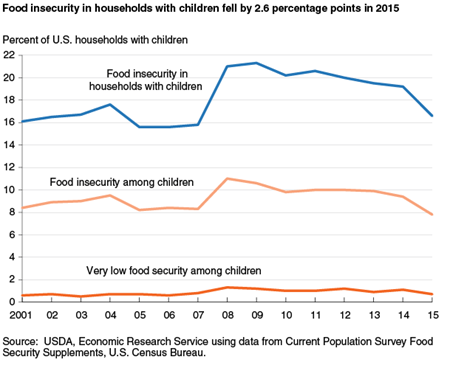Food Insecurity Among Children Declined to Pre-Recession Levels in 2015

The year 2015 marked the most significant annual improvement in food security since the Great Recession ended in 2009. The share of U.S. households that were food insecure—those that had difficulty at some time during the year providing enough food for all their members due to a lack of resources—fell from 14.0 percent in 2014 to 12.7 percent in 2015. Declines in food insecurity were even larger for the Nation’s children. In 2015, 16.6 percent of households with children were food insecure, down from 19.2 percent in 2014, meaning that 2.2 million fewer children in 2015 lived in households that had trouble putting adequate food on the table for all their members.
Despite the improvements year to year, 13.1 million U.S. children still live in food-insecure households. Inadequate or skipped meals take a toll on a family and its members. Research has found that children in food-insecure households face higher risks of iron deficiency anemia; more frequent stomach aches, headaches, and colds; and higher hospitalization rates. Children living in food-insecure households are also at risk for developmental problems and are more likely to score lower on math and reading tests or to repeat a grade.
Members within a household may be affected differently by food insecurity. Even when parents reduce their own food intake due to household food insecurity, they often try to ensure that their children get enough to eat. In about half of the food-insecure households with children in 2015, or 8.8 percent of all U.S. households with children, food insecurity was only reported among adults. But, in 7.8 percent of all U.S. households with children in 2015, one child or more in the household was also reported to be food insecure. In households with food insecurity among children, both children and adults lacked consistent access to adequate, nutritious food at some time during the year. The 7.8-percent prevalence of food insecurity among children in 2015 was a decline from 9.4 percent in 2014. Food insecurity among children peaked at 11.0 percent in 2008 following the late 2007 onset of the Great Recession.
A subgroup of food-insecure children face a more severe situation—very low food security. In 0.7 percent of U.S. households with children in 2015, caregivers reported that children were hungry, skipped a meal, or did not eat for a whole day because there was not enough money for food. Like food insecurity among children, very low food security among children was also down from its peak of 1.3 percent in 2008.
Household Food Security in the United States in 2015, by Alisha Coleman-Jensen, Matthew P. Rabbitt, Christian A. Gregory, and Anita Singh, ERS, September 2016
Food Insecurity in Households With Children: Prevalence, Severity, and Household Characteristics, 2010-11, by Alisha Coleman-Jensen, William McFall, and Mark Nord, USDA, Economic Research Service, May 2013
Food Security in the United States, by Alisha Coleman-Jensen, Christian A. Gregory, and Matthew P. Rabbitt, USDA, Economic Research Service, October 2023


